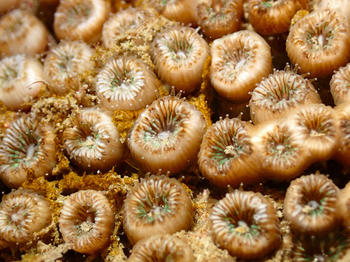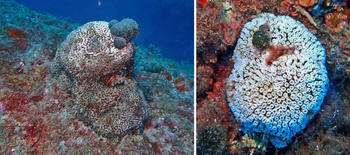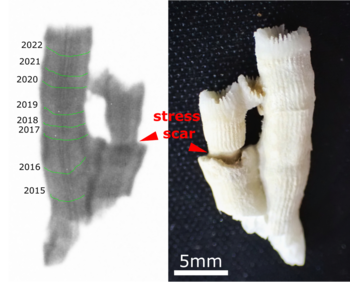Cladocora caespitosa: a temperate coral growing in a climate change hotspot
Cladocora caespitosa: a temperate coral growing in a climate change hotspot
Bildquelle: Marina J. Vergotti
Colonies of Cladocora caespitosa growing in the Montgrí Natural Parc (Catalonia, Spain). The picture on the left shows a colony with partial mortality, while picture on the right shows a colony that completely died very recently
Bildquelle: Marina J. Vergotti
X-ray of a Cladocora caespitosa fragment showing a mark of stress estimated to have happened during the summer of 2017.
Bildquelle: Marina J. Vergotti
News vom 29.01.2024
Korallen im Mittelmeer, einem Hotspot des Klimawandels: Cladocora caespitosa
Das Mittelmeer wird oft als "Hotspot des Klimawandels" bezeichnet. Für die Menschen, dort leben, wird dies zunehmend deutlich, da Stürme immer häufiger und heftiger werden, Dürren zur neuen Normalität werden und Hitzewellen jedes Jahr neue Rekorde brechen. Dabei könnte leicht übersehen werden, dass die Meeresumwelt des Mittelmeers genauso anfällig ist wie ihr terrestrisches Pendant. Tatsächlich steigen die Temperaturen hier drei Mal schneller als im Rest der Welt, was den Prozess der „Tropikalisierung“ begünstigt und die Ansiedlung potenziell invasiver tropischer Arten erleichtert, was wiederum zu umfangreichen Absterbeereignissen in benthischen Gemeinschaften führen kann. Als Folge davon treten irreversible Verschiebungen in der Artenverteilung auf, die die Zusammensetzung von Gemeinschaften und ihre Dynamik verändern.
Cladocora caespitosa (umgangssprachlich „Rasenkoralle“) ist eine Koralle, die endemisch im Mittelmeer vorkommt und ein Beispiel für eine Art ist, die von solchen klimatischen Ereignissen betroffen ist. Als einzige Koralle in der Region mit dem Potenzial, Riffe zu bilden, ist sie eine wichtige Bioingenieurart für die benthischen Ökosysteme des Mittelmeers, indem sie Lebensraum und Schutz für viele Arten von Algen, Polychaeten, Krebstieren, Schwämmen und mehr bietet.
Ihre begrenzte Kapazität zur Verbreitung während der Fortpflanzung, ihre langsame Lebensdynamik und die wiederkehrenden Massensterbeereignisse, die diese Art in den letzten drei Jahrzehnten betrafen, machen sie besonders anfällig für Umweltstressoren, insbesondere die, die mit dem Klimawandel zusammenhängen. Daher steht sie seit 2015 auf der Roten Liste gefährdeter Arten der IUCN und ist in einer Reihe von Mittelmeerländern geschützt. Diese Tatsache hat C. caespitosa in den Mittelpunkt mehrerer Forschungsprojekte gerückt, die sich auf ihre Verbreitung und Sterblichkeitsraten im Zusammenhang mit zunehmend häufigen Hitzewellen im Meer konzentrieren. Dennoch ist sie im Vergleich zu ihren tropischen Verwandten noch relativ wenig erforscht, und es muss noch viel über die subletalen Reaktionen dieser Koralle auf den Klimawandel verstanden werden.
Korallen spiegeln Veränderungen in ihrer Umwelt wider, indem sie ihre Wachstumsmuster verändern, die in ihren Skeletten aufgezeichnet werden. Korallen reagieren ebenso wie Bäume auf saisonale Zyklen, indem sie jedes Jahr in ihrem Skelett Wachstumsbänder mit hoher und niedriger Dichte ablagern. Diese Bänder können mithilfe von Computertomographie (CT)-Scans oder Röntgenaufnahmen sichtbar gemacht und dazu verwendet werden, die Lebensgeschichte der Korallen zu rekonstruieren, was wiederum helfen kann, Veränderungen in ihrer Umwelt zu verstehen. Durch die Rekonstruktion ihres Wachstums ist es auch möglich, Informationen über vergangene Stressereignisse wie marine Hitzewellen zu extrahieren, die zu anomalen Wachstumsmustern führen können.
Im Rahmen des EU-geförderten Projekts „MaCoBioS“ untersuchen wir, wie C. caespitosa auf Veränderungen der Meerestemperatur (wie marine Hitzewellen) und saisonale Variationen des pH-Werts reagiert. Dazu untersuchen wir Korallenskelette von mehreren Standorten im nordwestlichen Mittelmeer mithilfe von Röntgenstrahlen, um ihre Wachstumsbänder zu messen und zu analysieren, wie sich diese Umweltveränderungen auf das Skelettwachstum der Korallen auswirken. Die Korallenskelette werden im Labor weiter untersucht, um ihre chemische Zusammensetzung und die Veränderungen entsprechend der Jahreszeiten zu analysieren. Das Ziel ist es, die Stressantworten dieser Koralle auf marine Hitzewellen besser zu verstehen, indem nach Toleranzgrenzen und Resilienzmustern gesucht wird. Wir möchten auch ein besseres Verständnis dafür erhalten, wie die Korallen auf saisonale Veränderungen der Eigenschaften des Meerwassers reagieren und wie sich diese Reaktionen auf die Fähigkeit der Korallen auswirken, Stressereignisse zu bewältigen. Diese Informationen sind entscheidend für die Entwicklung wirksamer Managementstrategien zum Schutz dieser Arten.
In kommenden Blogbeiträgen, werden wir genauer darauf eingehen, wie diese Korallenart auf die Herausforderungen des Klimawandels reagiert.
Verfasst von Marina J. Vergotti, Freie Universität Berlin
Die Studie wurde durch Mittel des Forschungs- und Innovationsprogramms Horizont 2020 der Europäischen Union unter der Fördervereinbarung Nr. 869710 finanziert (EU-MaCoBioS - https://macobios.eu/).
The Mediterranean Sea is often referred to as a “climate change hotspot”. For people living around the Mediterranean basin, this is becoming increasingly obvious, as storms become more violent and frequent, droughts become the new norm and crushing summer heatwaves hit new records every year. But in the midst of these events, it might be easy to forget that the Mediterranean marine environment is just as vulnerable as its terrestrial counterpart. Indeed, with temperatures increasing three times faster than the rest of the globe, the Mediterranean Sea is prone to a tropicalisation process that facilitates the settlement of potentially invasive tropical species, and is responsible to extensive mortality events in benthic communities. As a result, irreversible shifts in species distribution are occurring, changing the composition of communities and their dynamics.
Cladocora caespitosa (commonly known as cushion coral) is a temperate coral endemic to the Mediterranean, and a good example of a species impacted by such climatic events. As the only coral in the region with the potential to build reefs, it is a key bioengineering species for Mediterranean benthic ecosystems, providing habitat and shelter to many species of algae, polychaete, crustaceans, sponges, and more. While it is more common during a dive to find a handful of football sized colonies of this coral spread on the bottom, it is still possible to find places around the Mediterranean with extensive reef-like formations.
Its limited capacity to spread during reproduction, its slow-life dynamic and the recurring mass mortality events affecting this species during the last three decades make it especially vulnerable to environmental stressors, including those linked to climate change. As a result, it has been a part of the IUCN red list of endangered species since 2015, and is protected in a number of Mediterranean countries. This fact has put C. caespitosa at the centre of several research projects focusing on its distribution and long-term responses to increasingly frequent marine heatwaves. However, it is still relatively understudied compared to its tropical relatives and much still needs to be understood regarding the sub-lethal responses of this coral to climate change.
Corals reflect changes in their environment by altering their growth patterns, which are recorded in their skeletons. Indeed, just as trees respond to seasonal cycles by depositing a pair of growth rings every year, so do corals by depositing in their skeleton a couplet of growth bands of high and low density. These bands can be revealed using methods such as computer-tomography (CT) scanning or X-rays, and used to “go back in time” by reconstructing the corals life-history, which can in turn help understand changes in their environment. By reconstructing their past growth, it is also possible to extract information about past stress events, such as marine heatwaves, that can result in anomalous growth patterns visible in the coral growth bands.
Thanks to the EU-funded MaCoBioS project, we strive to study how C. caespitosa responds to seawater temperature changes (such as marine heatwaves) and seasonal variations of pH. For that, we study coral skeletons from several sites in the NW Mediterranean using X-rays, to measure their growth bands and analyse how these environmental changes are affecting coral skeletal growth. The coral skeletons are studied further in the lab to analyse their chemical composition and the changes according to the seasons. The goal is to understand better the stress responses of this coral to marine heatwaves, by checking for tolerance limits and for resilience patterns. We also want to get a better understanding of how the corals respond to seasonal changes in seawater properties, and how these responses affect the corals capacity to withstand stress events. This information is crucial for the development of effective management strategies to protect these species.
Stay tuned for our upcoming blog posts, where we'll delve deeper into how this coral species responds to the challenges posed by climate change.
The study received funding from the European Union's Horizon 2020 Research and Innovation Programme under Grant Agreement no. 869710 (EU-MaCoBioS - https://macobios.eu/).
Written by Marina J. Vergotti, Freie Universität Berlin
Telefon +49 30 838 60905
E-Mail m.vergotti@fu-berlin.de
Malteserstrasse 74-100, Haus C, Room C.102
12249 Berlin





